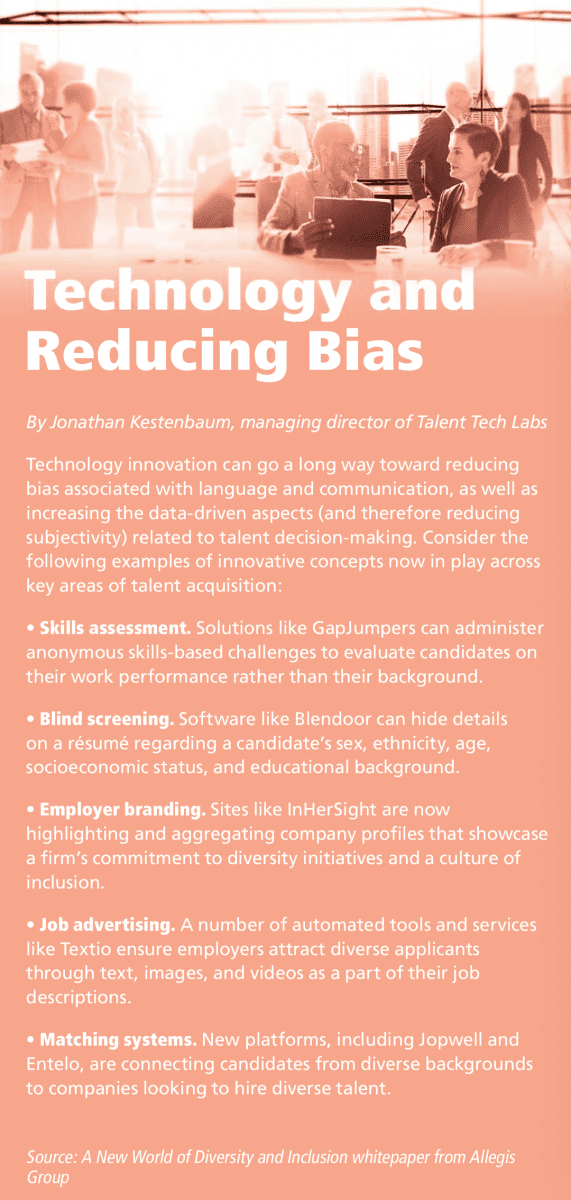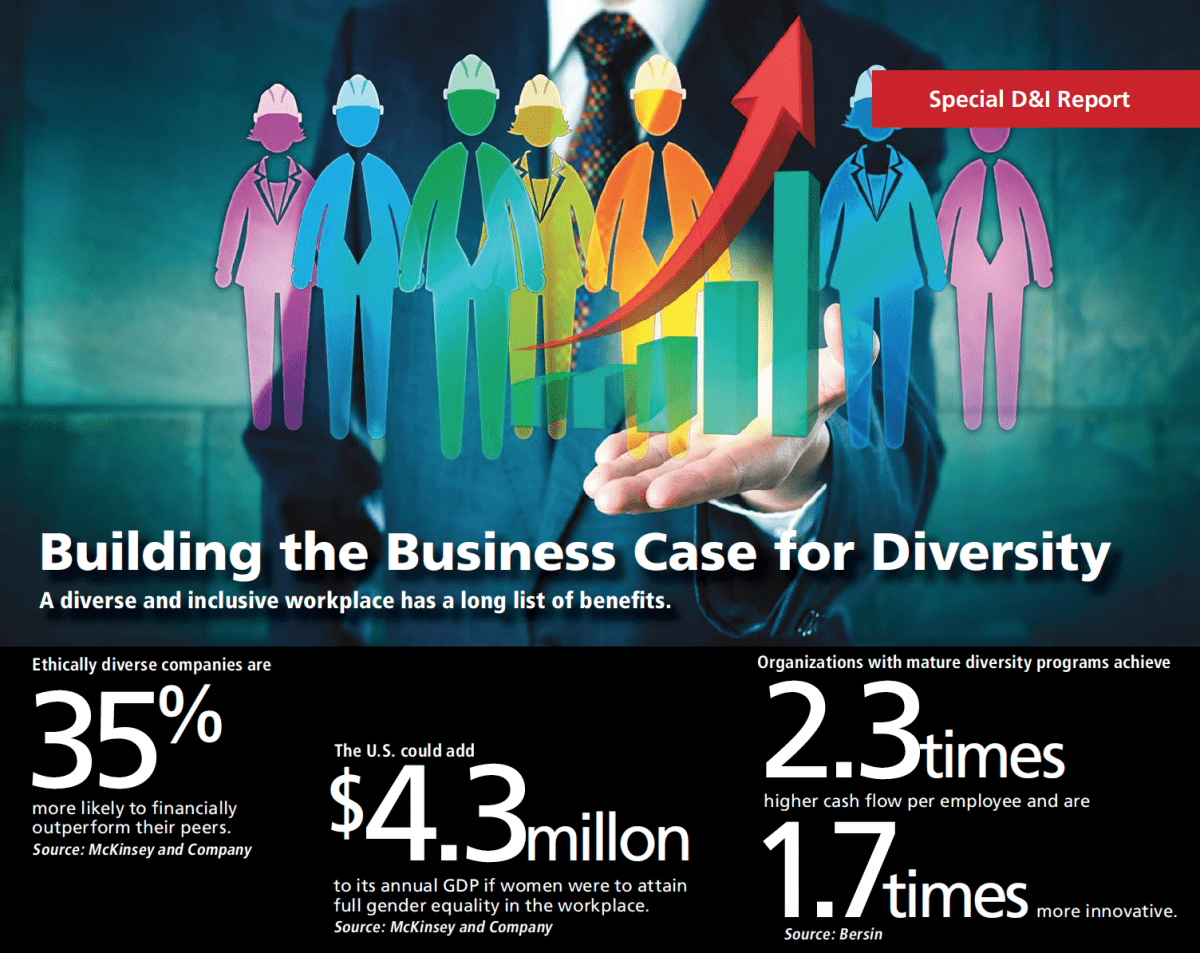A roundup of CHROs and TA leaders share best-in-class D&I strategies.
By Debbie Bolla
The recent #MeToo movement shined a spotlight on the mistreatment of women and minorities in all realms of society, and the workplace was no exception. As cases continue to make headlines, they encourage organizations to rethink their polices and practices, with HR leading the charge to change. This crusade for fairness among all workers is clearly connected to an organization’s diversity and inclusion (D&I) strategy.
“Diversity isn’t a program or policy. Diversity is a way of thinking -a cultural golden thread that must be woven throughout the culture and practices of a company,” explains Joan Buccigrossi, global head of diversity and inclusion for Alcon, a Novartis Company. “A corporate culture that leverages diversity is one where leaders see being inclusive as a leadership skill, not an add on. When a company has leaders, managers, and associates who are inclusive, innovation, productivity, and satisfaction are baked into the culture.”
Many HR executives argue that an inclusive workforce begins and ends with culture. “It really is about the culture,” says Christine Esckilsen, chief human capital officer for Piper Jaffray. “A lot of this comes down to creating a workplace culture where women thrive.”
In what ways can companies encourage the growth and development of women and minorities within the workplace? Esckilsen recommends that organizations:
- build social capital;
- provide opportunities to create important connections and gain influence;
- get executive team sponsorship; and
- offer mentorship programs and role models.
Peggy Anderson, vice president of global talent acquisition and diversity for Blackbaud, also sees the value in providing opportunities and support to individuals in minority groups. For example, Blackbaud hosts a Women’s Executive Summit for every female leader within the organization and has launched employee-led affinity groups to support their strategy.
“These events demonstrate a commitment to D&I throughout the company, the community, and our customers,” says Anderson. “They create a community where peers can support peers and create a culture of D&I.”
AMN Healthcare is an organization that has been quite successful at achieving gender equality through long-term policies around hiring and promoting, says Julie Fletcher, chief talent officer. “We adopted an all-inclusive talent strategy where we purposefully sought the best-quality team members among all people. Diversity programs are great as one piece of the building blocks of a true culture of equality,” she explains.
AMN Healthcare’s purposeful strategy has the numbers to back its effectiveness:
- Sixty-six percent of the entire team company-wide consists of women;
- Sixty-two percent of supervisors and senior managers are women;
- Forty-four percent of corporate directors and above are women;
- Twenty-five percent of the Board of Directors are women; and
- The executive team includes a female CEO, chief legal officer, chief clinical officer, chief talent officer, and a division president.
Voya Financial is another organization that has been recognized with an impressive list of accolades for their diversity and inclusion efforts, including being listed on the inaugural 2018 Bloomberg Gender-Equality Index for financial services; being honored as a 2018 World’s Most Ethical Company® by the Ethisphere Institute for the fifth consecutive year; and being named to Fortune Knowledge Group’s Top 20 Gender Diversity Index list, among others.
And this did not happen by accident. “We believed that culture and diversity were an accelerator of our performance, and we knew that we needed a leadership team to invest in and realize that importance,” says Kevin D. Silva, EVP and CHRO of the organization.
What steps did Voya take? The company started with its board. “We purposefully moved our own internal forces and reconstructed our board. In 2013, after our initial public offering, we had nine male board members. Today, 50 percent of the independent directors on the board of directors are women and 13 percent are racially/ethnically diverse. Boards of directors should have a combination of genders, ethnicities, age, and skills that reflect the company and its customers,” Silva says.
Diversity in Hiring
In addition to company culture, D&I practices are critical in the hiring process. Silva believes that an organization’s talent acquisition strategy is intricately tied to a culture of inclusivity. “This addresses equality in leadership opportunities, parity of promotions, a rigorous performance management process to internally promote and retain employees of diverse backgrounds, and strategic recruiting,” he explains.
Blackbaud’s Anderson recommends that hiring managers and recruiters be held accountable to service level agreements that measure a diverse slate of candidates. There is strength in numbers: Fast Company reports that the chances of hiring a woman are 79 times greater when there are two female candidates in the talent pool when compared to one, and the chances of hiring a minority are 194 times greater when there are two minority applicants.
 Diversity training through a specific recruiting event can provide hiring mangers the ability to hit diverse hiring targets, Anderson says. And communicating wins also makes a difference. “Be sure to provide positive recognition and encouragement to the teams -recruiters and hiring managers -that embrace D&I,” she says. These efforts will not go unnoticed and play a large role in creating a culture of inclusion.
Diversity training through a specific recruiting event can provide hiring mangers the ability to hit diverse hiring targets, Anderson says. And communicating wins also makes a difference. “Be sure to provide positive recognition and encouragement to the teams -recruiters and hiring managers -that embrace D&I,” she says. These efforts will not go unnoticed and play a large role in creating a culture of inclusion.
Jeff Bettinger, global head of talent management and organizational development for Alcon, says it’s also important to take steps to limit unconscious bias. “Best practices include blind screening where all personal, demographic, and names are removed from resumes before submission to hiring managers so that managers only review qualifications and skills,” he recommends.
In addition, he adds that leveraging diverse interview panels helps candidates to “see themselves” as part of the company because it provides the opportunity to speak with people who may share similar characteristics. “It also allows diverse points of view to provide feedback on candidates and engage various points of view,” Bettinger adds.
Sourcing from diverse pools by advertising to diverse populations will help keep perspectives and experiences fresh, populating qualified talent pipelines. Organizations should set up targets to help keep talent acquisition teams on track, Bettinger says.
Best Practices
A study from Allegis Group found that 72 percent of organizations have a diversity and inclusion strategy in place but less than half named it as a priority for business success. To help move the needle, organizations should consider the following best practices:
- Ensure policies and procedures enhance a diverse culture. Silva says this can be achieved through a combination of “evolving benefit offerings to ensure employees’ broad spectrum of needs are met; equality in all decisions related to employment, including recruiting, development and compensation; reasonable accommodations to facilitate the employment of people with disabilities or who are pregnant; and an intolerance of discrimination and harassment.”
- Don’t boil the ocean. “Only start things that you can actually accomplish and do,” says Anderson. A multi-year strategy and various stakeholder support will help organizations find success.
- Empower managers to execute D&I objectives. “Leaders, managers, and associates must have the skills to work inclusively,” says Alcon’s Buccigrossi. “It isn’t something that necessarily comes naturally. We like to work with people who are like us because it’s familiar and comfortable. But working inclusively is a skill that can be learned and, with practice and focus, people can excel at it.”
- Earn executive buy-in. “Creating a culture of diversity starts with a commitment from a company’s senior-most executives to acknowledge diversity as a critical driver of financial performance and a requirement for success and sustainability,” says Silva. “Voya, I believe, has been a leader in demonstrating how companies that hold themselves to a certain standard of diversity succeed and are the best places to work.”
- Measure what matters. Diversity metrics have evolved beyond the traditional approach of setting hiring quotas. But showing success still remains important to future growth and investment in programs. Considering that a survey from Allegis Group finds that only 37 percent of organizations have diversity hiring goals, the time is now for organizations to reconsider their metrics. A New World of Diversity and Inclusion whitepaper from Allegis Group suggests:
o To drive inclusion in the employee experience, track employee satisfaction survey scores.
o To reduce bias in promotion, compensation, or development opportunity, review employee retention rates.
o To identify barriers to promotion, measure the diversity of employees by management and leadership positions.
o To measure pay inequity and bias in promotion decisions, track employee compensation by role.
- Constantly evolve. “Our efforts to further expand diversity and our inclusive culture are strengthened by what we’ve done in the past,” says Fletcher. “We have instituted a number of programs focused on our workforce, workplace, and the communities that we serve -such as a hiring strategy for diversity, unconscious bias training, and employee resource groups to further propel our diversity and inclusion efforts. It is these actions and our transparency on where we are and where we want to go to continually build a better culture of equality that’s making our company truly diverse.”
LEARN MORE
[metaslider id=”11678″]















